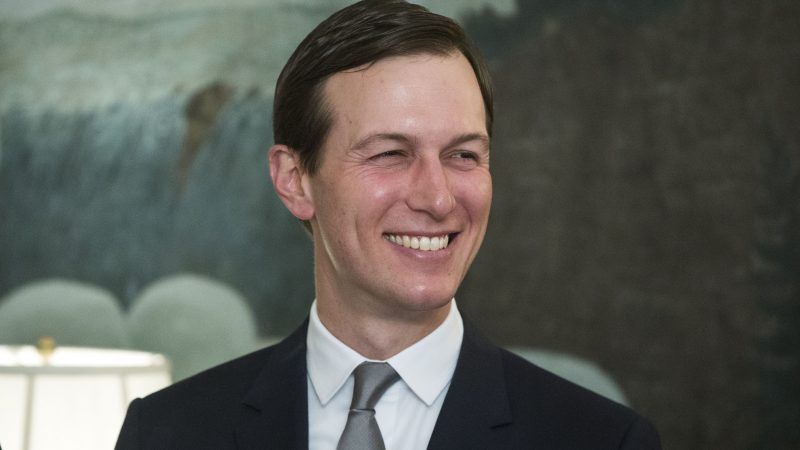White House Increases Temporary Work Visas; Proposes Keeping Immigration Flat
Restrictionist allies seethe as Jared Kushner's reform plan fails to reduce overall numbers.

The Federal Register, as of this morning, officially includes a Department of Homeland Security notice that the number of seasonal nonfarm visas (H-2Bs) for the fiscal year ending Sept. 30 will increase from 66,000 to 96,000, the highest total in a dozen years. Since those jobs—about three-quarters of which are filled with visiting guest workers from south of the U.S.-Mexico border—are divvied up between the winter and summer hiring seasons, the move effectively doubles this summer's temporary visas, even as President Donald Trump keeps insisting that the "country is full."
The increase comes after administration officials Tuesday briefed a group of Republican senators on the long-awaited comprehensive immigration reform package spearheaded by Jared Kushner, Trump's son-in-law and senior advisor. That plan would shift the current process toward a more merit-based, high-skills system, and potentially close down such programs as the diversity lottery visa, in addition to throwing more billions at border security. "We're working on keeping the [overall] number [of immigrants] the same," a senior administration official told Politico. "We're just changing the composition. … The No. 1 goal in that is to make sure that we're not bringing in low-skilled labor."
It has not escaped restrictionists' attention that the administration's words and deeds regarding low-skilled visas are at tension. One of the senators at the meeting, Arkansas' Tom Cotton, expressed sharp disappointment at the telegraphed (if low-key) goosing of H-2Bs.
"[Our] immigration system should prioritize the needs of U.S. citizens over cheap foreign labor," Cotton said in a statement Monday. "Allowing an additional 30,000 seasonal workers into the country forces Americans to compete for jobs against non-citizens who drag down wages. We should be setting immigration policies that support wage growth and employment for Americans instead of encouraging a race to the bottom by importing low-cost labor."
Cotton is a co-sponsor of the recently introduced Reforming American Immigration for a Strong Economy (RAISE) Act, which would cut legal immigration in half. The underlying theory, long espoused by people such as Trump immigration Advisor Stephen Miller, is that reducing visas for low-skilled jobs, paired with cracking down on illegal immigrants, will raise employment numbers and wages among non-college-educated Americans. Proponents point to the recent uptick in wages as proof the theory works.
When businesses have to compete for workers, they raise wages and improve working conditions. This is finally happening for American workers for the first time in ages. Importing a flood of cheap foreign labor on more H-2B visas threatens that growth. https://t.co/krVX1b2ZNn
— Tom Cotton (@SenTomCotton) May 7, 2019
Those attempting to study the narrow issue of low-skilled immigration's impact on the wages of lesser-educated Americans (as opposed to, say, the broader impact on the economy and social services) have come to more mixed conclusions. Surveying the literature, Reason columnist Veronique de Rugy noted in 2013 that "economists have a hard time finding evidence that this effect is as harmful as people believe. The largest negative impact measured comes from the work of Harvard University's George Borjas and Lawrence Katz. They find that a long-term impact of Mexican immigration on the wages of high school dropouts of less than 5 percent. Other economists have found that low-skilled immigration can have small but positive effects on the wages of native high school dropouts, up to 0.6 percent." (Read a 2016 debate between Borjas and Reason's Shikha Dalmia here.)
Until now, today's H-2B expansion has been just about the only visa increase for an administration that has relentlessly reduced in-flows. As Stuart Anderson pointed out here in March:
In 2018, only 22,491 refugees were admitted, down from 84,994 in 2016. … Immigrant visas issued in the "immediate relatives" category (spouses, children, and parents of U.S. citizens) declined from 254,430 in 2017 to 236,526 in 2018, a fall of 7 percent. … Temporary visas issued to a fiancé of a U.S. citizen fell 29 percent from 2017 to 2018. And immigrant visas denied on "public charge" grounds increased 316 percent during that same time. […]
The State Department issued 30,644 fewer F-1 student visas in 2018, an 8 percent drop over the previous year. The total decline between 2016 and 2018 was 108,799 or 23 percent.
So even Kushner's proposal to keep visa numbers flat is a reversal of sorts. Which is intriguing, since—like the comprehensive immigration reform efforts of 2006-07 and 2013—this plan is likely a legislative non-starter.
"If they propose something that doesn't cut the numbers but just moves to a merit-based system, pretty much uniformly Democrats and all of the parts of the media that are allied with the Democratic Party will come out against it wholeheartedly, and a lot of their allies are going to come out against it wholeheartedly," Center for Immigration Studies' Steven Camarota told Politico. "It's not clear for them how it's a winning strategy to have their own side divided and the other side unified."
Trump, characteristically, has been all over the map on the issue, including his ad-libbed and non-believable claim in this year's State of the Union Address that he wants legal immigrants to come in "the largest numbers ever." The president has reportedly signed off on Kushner's plan, but previous legislative go-rounds have demonstrated that POTUS is not the most consistently reliable actor.
The case for expanding, instead of flatlining or restricting, the number of visas, is fourfold: 1) It's generally better for the United States, 2) it's definitely better for the migrants themselves, 3) it better reflects existing supply and demand, and therefore, 4) it would funnel fewer border-crossers and visa-overstayers into the black market.
Speaking of the latter, how is our anti-illegal immigration president doing?


Show Comments (17)